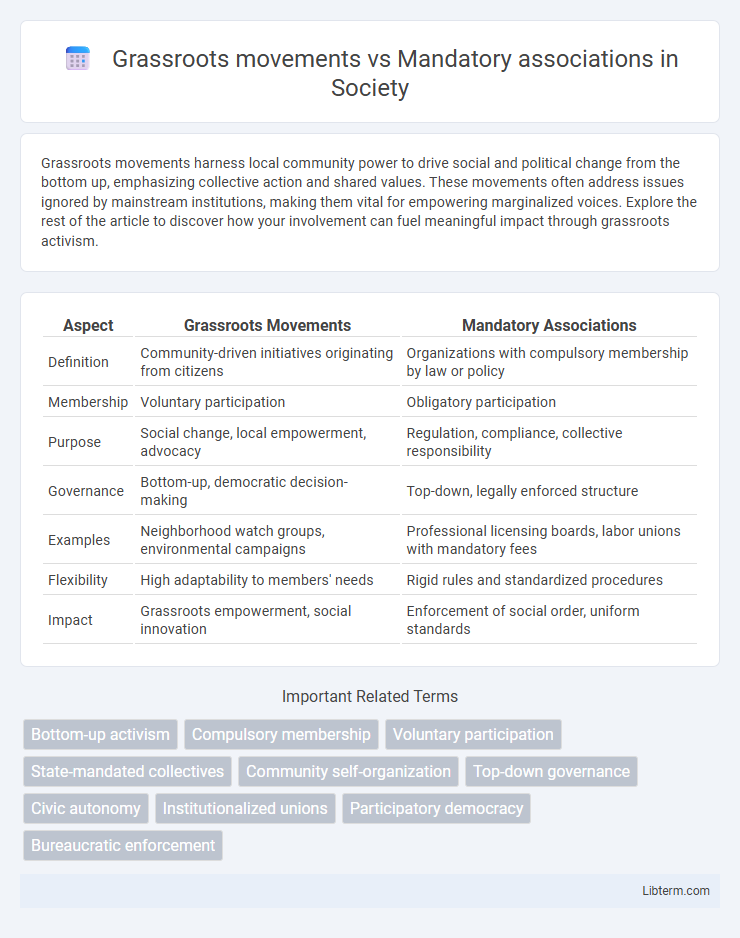Grassroots movements harness local community power to drive social and political change from the bottom up, emphasizing collective action and shared values. These movements often address issues ignored by mainstream institutions, making them vital for empowering marginalized voices. Explore the rest of the article to discover how your involvement can fuel meaningful impact through grassroots activism.
Table of Comparison
| Aspect | Grassroots Movements | Mandatory Associations |
|---|---|---|
| Definition | Community-driven initiatives originating from citizens | Organizations with compulsory membership by law or policy |
| Membership | Voluntary participation | Obligatory participation |
| Purpose | Social change, local empowerment, advocacy | Regulation, compliance, collective responsibility |
| Governance | Bottom-up, democratic decision-making | Top-down, legally enforced structure |
| Examples | Neighborhood watch groups, environmental campaigns | Professional licensing boards, labor unions with mandatory fees |
| Flexibility | High adaptability to members' needs | Rigid rules and standardized procedures |
| Impact | Grassroots empowerment, social innovation | Enforcement of social order, uniform standards |
Understanding Grassroots Movements: Definition and Origins
Grassroots movements originate from the collective efforts of ordinary individuals driven by shared concerns, typically arising from local communities seeking social or political change. These movements emphasize bottom-up organization, empowering participants to influence policy and public opinion without reliance on formal institutions. Understanding their definition and origins highlights their role in amplifying marginalized voices and fostering democratic engagement.
What Are Mandatory Associations? Key Features Explained
Mandatory associations are organizations or groups that individuals must join due to legal, professional, or regulatory requirements, ensuring unified standards and collective representation. Key features include compulsory membership, standardized dues or fees, and often, a formal structure that enforces adherence to rules or codes of conduct. Unlike grassroots movements driven by voluntary participation and shared interests, mandatory associations play a regulatory or governing role within specific industries or professions.
The Role of Community Engagement in Grassroots Movements
Community engagement serves as the cornerstone of grassroots movements, driving collective action and fostering a sense of ownership among participants. These movements thrive on local involvement and collaboration, enabling communities to address specific issues through shared goals and direct participation. In contrast to mandatory associations, grassroots initiatives rely on voluntary commitment and active citizen engagement, which amplifies their adaptability and responsiveness to community needs.
Structure and Governance: Grassroots vs. Mandatory Associations
Grassroots movements typically operate with decentralized structures, emphasizing participatory governance where members have significant influence over decision-making processes. Mandatory associations, in contrast, often feature centralized governance with formal hierarchies and standardized rules imposed by legal or institutional mandates. The flexible and organic nature of grassroots governance fosters adaptability, while mandatory associations prioritize uniformity and regulatory compliance.
Membership Dynamics: Voluntary Participation vs. Obligation
Grassroots movements thrive on voluntary participation, attracting members driven by shared values, goals, and personal commitment, which fosters strong engagement and organic growth. In contrast, mandatory associations enforce membership through legal or organizational obligations, leading to a more static membership base with potentially lower individual motivation and engagement. The dynamic differences affect how each type of organization mobilizes resources, sustains member involvement, and achieves its objectives.
Impact on Social Change: Which Model Is More Effective?
Grassroots movements often drive social change by mobilizing local communities and fostering organic, bottom-up participation, making them highly effective in creating sustained cultural shifts. Mandatory associations, while capable of enforcing compliance through structured frameworks and legal mandates, may lack the deep personal engagement essential for long-term transformation. The effectiveness of social change largely depends on the balance between voluntary community empowerment found in grassroots models and the regulatory power inherent in mandatory associations.
Funding and Resources: Grassroots Challenges vs. Mandated Support
Grassroots movements often face significant challenges in securing consistent funding and resources due to reliance on donations, volunteer efforts, and limited access to institutional support. In contrast, mandatory associations benefit from steady, government-mandated funding streams and organizational infrastructure, providing reliable resources for sustained activities. This financial disparity impacts the capacity of grassroots groups to scale programs and maintain long-term engagement compared to the stability enjoyed by mandated entities.
Accountability and Transparency in Each Approach
Grassroots movements prioritize accountability through direct participation, enabling members to influence decisions and maintain transparency via open communication channels and public forums. Mandatory associations often operate with formal governance structures that enforce accountability via regulatory compliance and standardized reporting mechanisms, ensuring transparency through official documentation and audits. Each approach balances transparency differently: grassroots movements emphasize collective oversight and responsiveness, while mandatory associations rely on institutionalized controls and formal accountability protocols.
Case Studies: Success Stories and Failures
Grassroots movements such as the Civil Rights Movement demonstrate success through community-driven advocacy and organic mobilization, fostering durable social change and policy reform. In contrast, mandatory associations like certain corporate unions often face challenges in member engagement and legitimacy, exemplified by failed efforts to mobilize workers' rights due to perceived top-down control. Case studies highlight that grassroots initiatives excel with widespread public buy-in, whereas mandatory associations struggle without voluntary commitment, impacting overall effectiveness and sustainability.
Future Trends: The evolving Relationship Between Grassroots and Mandatory Associations
Future trends indicate an increasing collaboration between grassroots movements and mandatory associations, leveraging each other's strengths to drive social and political change. Grassroots movements continue to influence policy innovation through localized, community-based initiatives, while mandatory associations provide structured resources and formal representation. The evolving relationship is characterized by hybrid models combining grassroots agility with institutional stability, enhancing advocacy effectiveness in addressing complex societal challenges.
Grassroots movements Infographic

 libterm.com
libterm.com